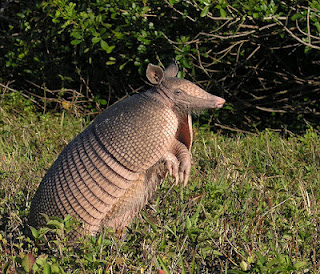
The Giant Armadillo (Priodontes maximus), colloquially Tatou, Ocarro, Tatu-canastra or Tatú Carreta, is the largest living species of armadillo.
It was once found widely throughout the tropical forests of eastern South America and now ranges throughout varied habitat as far south as northern Argentina.
This species is considered vulnerable to extinction.

These armadillos typically weigh around 28 kilograms (62 lb) when fully grown, but a 32 kilograms (71 lb) specimen has been weighed in the wild. A typical length is 89 cm (35 in), of which a third to two-fifths is likely to be accounted for by the tail.
The Giant Armadillo prefers termites and some ants as prey, and often consumes the entire population of a termite mound. It has been known to also prey upon larger creatures, sometimes consuming small mammals such as mice and rats.
The Giant Armadillo was classified as Endangered (EN — A1cd) on the World Conservation Union's Red List in 2002, and is listed under Appendix I (threatened with extinction) of the Convention on the International Trade in Endangered Species of Wild Flora and Fauna.
Conservation status

Vulnerable
If you liked this article, subscribe to the feed by clicking the image below to keep informed about new contents of the blog:






















0 comments:
Post a Comment
Do not insert clickable links or your comment will be deleted. Check the Notify me notifications to be notified via email of new comments. If I helped you with the post or with the answers to the comments, share on Facebook or Twitter. Thank you.